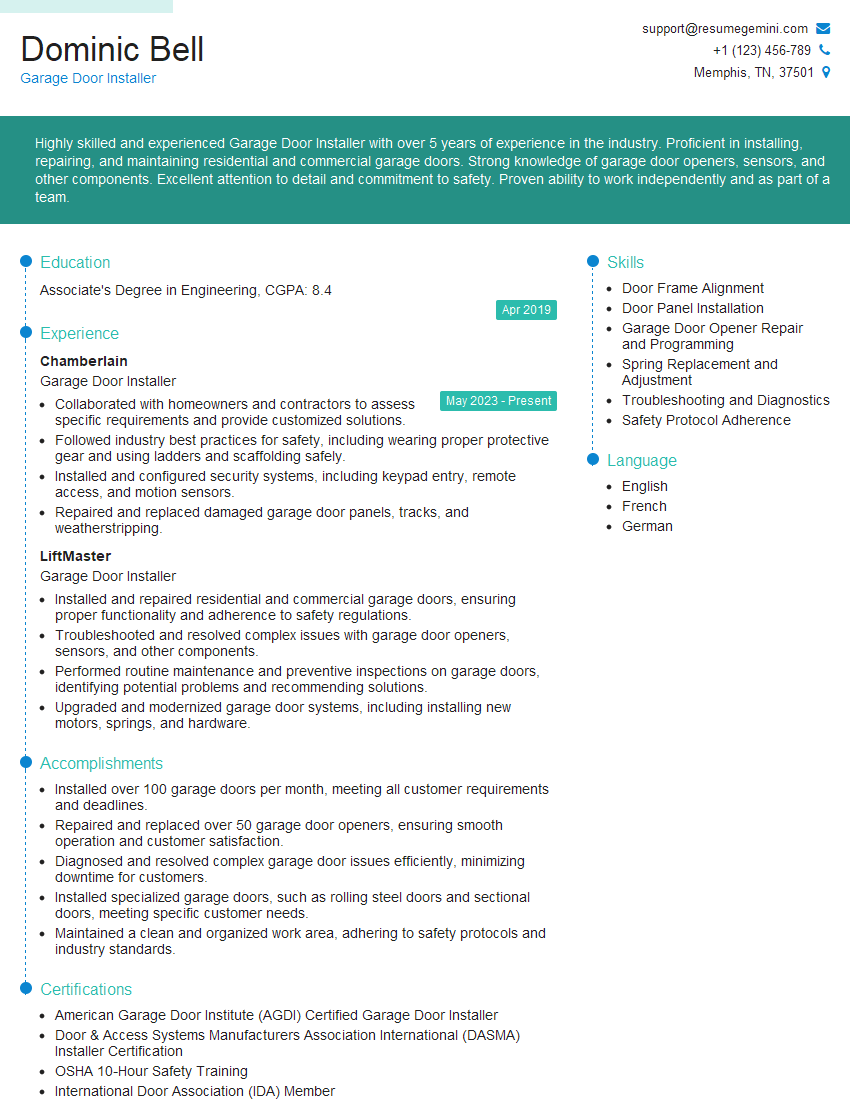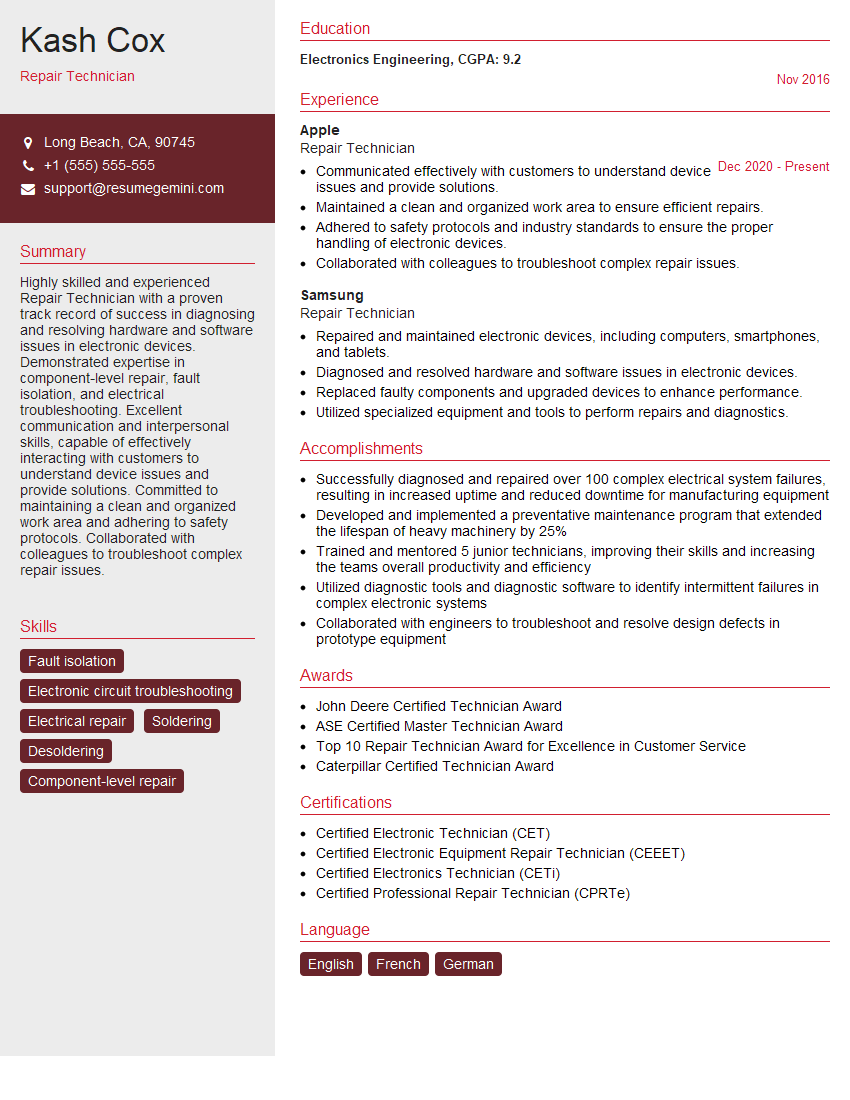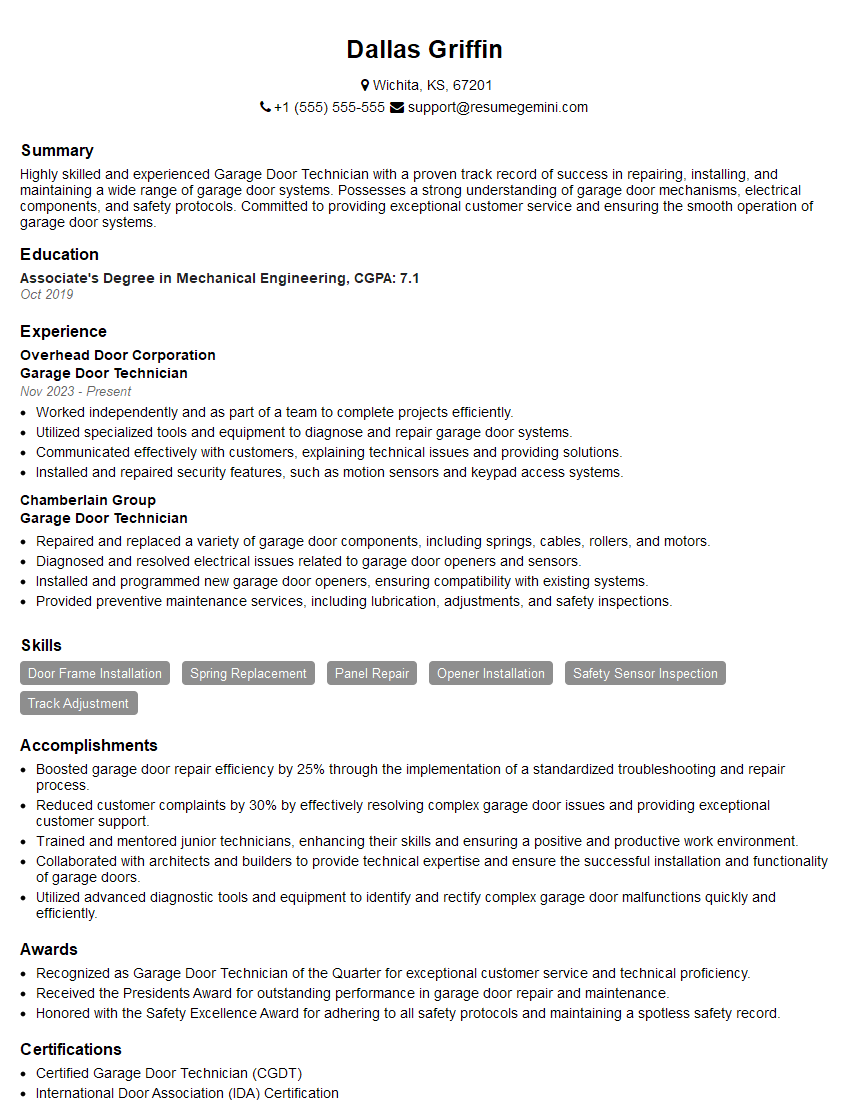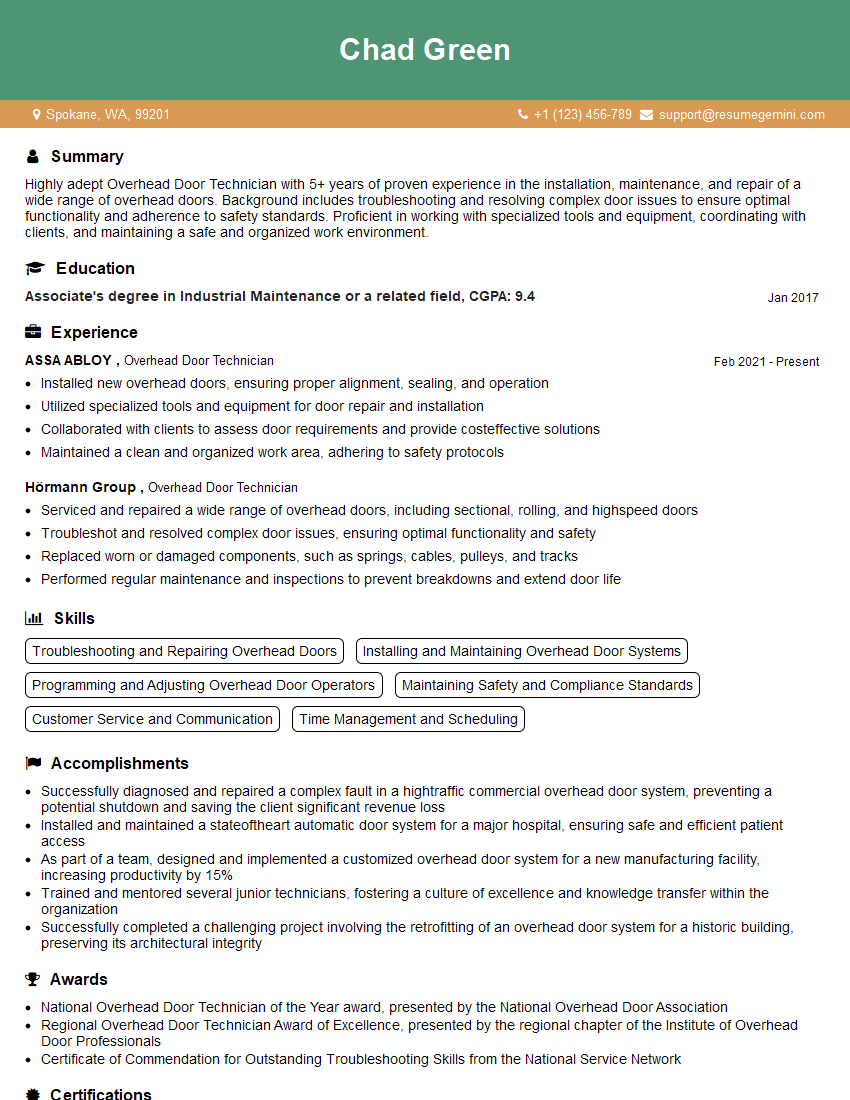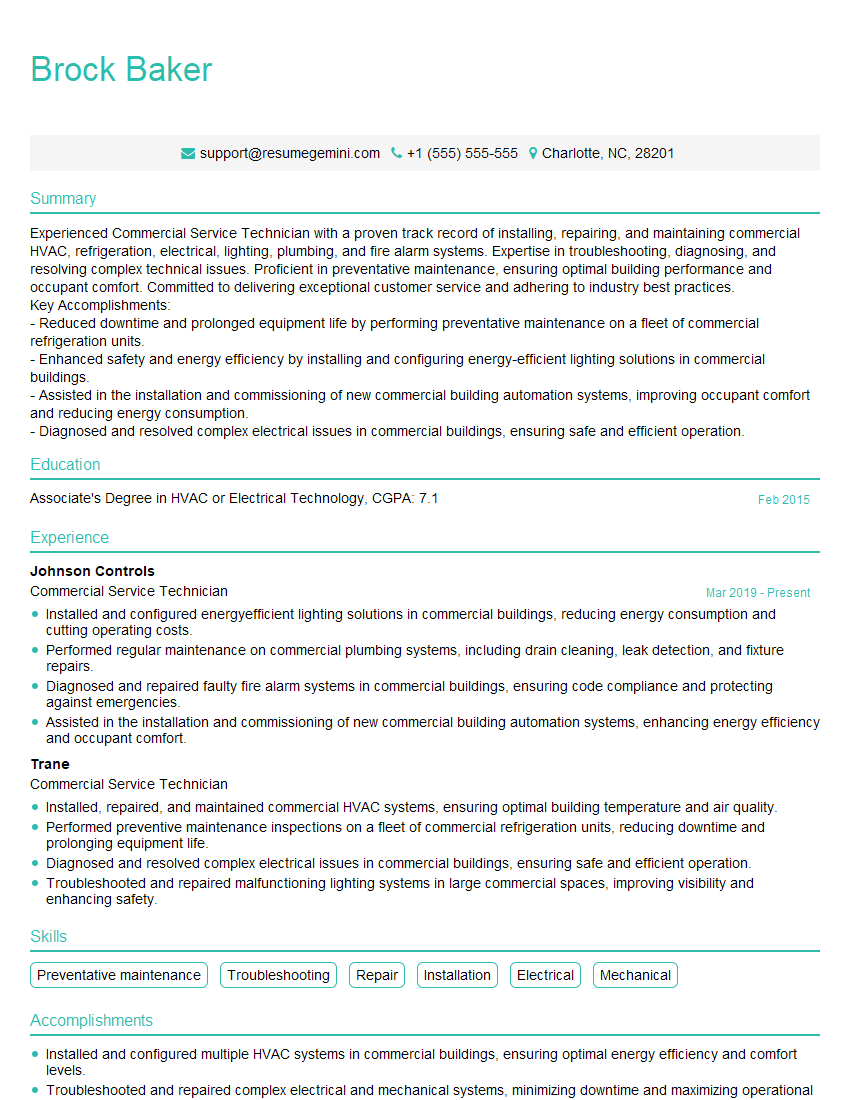Warning: search_filter(): Argument #2 ($wp_query) must be passed by reference, value given in /home/u951807797/domains/techskills.interviewgemini.com/public_html/wp-includes/class-wp-hook.php on line 324
Cracking a skill-specific interview, like one for Garage Door Cable Replacement, requires understanding the nuances of the role. In this blog, we present the questions you’re most likely to encounter, along with insights into how to answer them effectively. Let’s ensure you’re ready to make a strong impression.
Questions Asked in Garage Door Cable Replacement Interview
Q 1. Describe the different types of garage door cables.
Garage door cables are typically made of steel and come in two main types: lift cables and track cables. Lift cables are the most common; they’re the strong cables that run vertically alongside the door and are responsible for lifting and lowering it. They connect the door’s lifting mechanism (typically a drum or a spring system) to the bottom of the door. Track cables, on the other hand, are often thinner and run along the horizontal tracks, guiding the door’s movement. They’re less likely to break than lift cables. The specific type and diameter of the cable will depend on the size and weight of your garage door.
- Lift Cables: These are usually thicker and stronger, designed to handle the weight of the door.
- Track Cables: These are thinner and assist in guiding the door’s movement along the tracks.
Q 2. Explain the process of identifying a broken garage door cable.
Identifying a broken garage door cable is usually straightforward. The most obvious sign is a garage door that won’t open or close properly. You might hear a loud bang or snapping sound when the cable breaks. If the door is stuck halfway, or if one side of the door is significantly higher than the other, there’s a high probability of a broken cable. You’ll likely see the cable frayed, snapped, or detached from its fittings. Carefully inspect the cables along the sides of the door and pay close attention to where the cables attach to the door and the drum or spring system. A visual inspection will often reveal the problem.
Q 3. What safety precautions are crucial when replacing garage door cables?
Safety is paramount when dealing with garage door cables. Garage door springs are under immense tension, and improper handling can lead to serious injury. Always disconnect the power to the garage door opener before starting any work. Never attempt to work on a broken cable with the door in motion. Use safety glasses to protect your eyes from flying debris and wear heavy-duty work gloves to protect your hands. If you’re uncomfortable working with the springs, it’s best to contact a professional garage door technician. These high-tension springs can release unexpectedly, causing severe injury.
Q 4. How do you determine the correct cable length for replacement?
Determining the correct cable length is crucial. Incorrect length can lead to poor performance and even damage. You’ll need to measure the existing cable’s length – from its connection point on the door to its connection point on the drum. However, it’s often better to take the old cable to a garage door supply store for an exact match, and they’ll be able to provide you with the right one. Using a slightly longer cable than the original isn’t generally advisable.
Q 5. What tools are essential for garage door cable replacement?
You’ll need a few essential tools for this job. The most important are:
- Safety Glasses: To protect your eyes.
- Heavy-Duty Work Gloves: To protect your hands.
- Wire Cutters or Cable Snips: To cut the old cable.
- Pliers (Needle-nose and Slip-joint): For manipulating the cable and connectors.
- Screwdrivers (Phillips and Flathead): To remove and reinstall any necessary parts.
- Measuring Tape: To measure the cable length (if you can’t use the old cable as a reference).
- Replacement Cable: Obtain a cable of the correct type and length.
Having the right tools will make the job easier and safer.
Q 6. Describe the steps involved in replacing a broken garage door cable.
Replacing a garage door cable involves several steps. Remember, safety first – disconnect the power to the opener!
- Disconnect the old cable from the drum and the bottom bracket of the garage door. Use the appropriate tools to carefully remove the cable connections.
- Install the new cable. Thread the new cable through the appropriate pulleys and guides, and attach it securely to the bottom bracket and the drum, mimicking the original cable’s path.
- Check for proper routing. The new cable should run smoothly along the tracks and be properly secured at all attachment points.
- Test the door’s movement. Manually lift and lower the door to ensure it moves smoothly and without any binding or resistance.
- Check the tension and adjust if necessary. Improper tension will result in uneven door operation. (See next answer for details.)
- Reconnect the power to the opener and test the automatic operation of the door. If you encounter any issues, contact a professional.
Q 7. How do you ensure proper cable tension after replacement?
Ensuring proper cable tension is crucial for the safe and efficient operation of your garage door. The cables should be taut but not over-tightened. An improperly tensioned cable can cause the door to bind, move unevenly, or even cause further damage. To check the tension, manually open and close the door several times. Both sides of the door should move up and down smoothly and evenly. If one side is lagging, it indicates improper tension. If the cables are too loose, you might need to adjust them by slightly tightening the connections at the drum or bottom bracket. If too tight, carefully loosen them. If you’re unsure, it’s advisable to call a garage door professional to check the tension.
Q 8. What are the common causes of garage door cable breakage?
Garage door cable breakage is usually a result of wear and tear, but several factors accelerate this process. Think of the cables as the muscles of your garage door system; constant use and stress eventually weaken them.
- Age and Fatigue: Over time, cables become brittle and lose their strength, much like an old rubber band. This is the most common cause.
- Sudden Impacts: A forceful impact, such as a car bumping into the door, can snap a cable instantly. This is why it’s crucial to have a functioning safety sensor system.
- Improper Maintenance: Neglecting routine lubrication can lead to increased friction and wear on the cables and pulleys, hastening their demise.
- Incorrect Installation: If the cables aren’t installed correctly from the start, they’ll be under uneven tension, making them more prone to breakage. A poorly installed cable can unravel over time.
- Spring Issues: Faulty or broken garage door springs put excessive strain on the cables, dramatically shortening their lifespan. This is often a symptom of a larger problem, requiring professional attention.
Q 9. How do you troubleshoot a garage door that is off track due to a broken cable?
Troubleshooting a derailed garage door due to a broken cable requires a cautious and methodical approach. Safety is paramount; never attempt repairs without disconnecting the power to the opener.
- Assess the Damage: Carefully examine the door to identify which cable broke and the extent of the damage. Note if the door is severely off-track or if other components are damaged.
- Disconnect the Opener: This is crucial to prevent the door from unexpectedly moving and causing injury.
- Manually Lift the Door (If Possible): If the door isn’t excessively heavy, gently lift it off the track to ease the tension on the remaining parts. If you cannot safely lift it, proceed to the next step.
- Detach the Broken Cable: Once the tension is relieved, you can safely detach the broken cable. Note the routing of the cable for later reference. This might necessitate removing some panels for easier access.
- Re-attach the Door: After removing the damaged cable, carefully re-attach the door to the track. Then you can assess whether the springs need adjustment.
- Call a Professional: Unless you have extensive experience working with garage doors, it’s advisable to call a qualified technician for professional cable replacement.
Attempting complex repairs without proper training can lead to further damage and potential injury.
Q 10. Explain the difference between drum and spring cables.
The terms ‘drum cable’ and ‘spring cable’ refer to the cables’ location and function within the garage door system. They’re both essential for proper operation.
- Drum Cable: This cable winds around a drum located on the garage door opener motor unit. It’s responsible for the opening and closing movement of the door. Think of it as the primary driving force.
- Spring Cable: These cables connect to the torsion springs or extension springs above the garage door. They are essential for counterbalancing the weight of the door, making it easier to operate and preventing it from slamming down. These cables often run along the side of the door.
While both types of cables work together to manage the door’s movement, they have different roles and purposes.
Q 11. What are the signs that a garage door cable needs immediate replacement?
Several signs indicate that your garage door cable requires immediate attention:
- Visible Damage: Kinks, fraying, or broken strands are clear indications of a weakening cable that’s likely to fail soon. If you see any significant damage, replacement is necessary.
- Unusual Noises: Squealing, rattling, or snapping sounds during door operation are indicative of friction or wear on the cables and pulleys. This often precedes a cable break.
- Door Operation Issues: The door is slower to open or close, or it feels unusually heavy or resistant to movement. The door could feel like its being held back.
- Uneven Movement: The door doesn’t move smoothly along the tracks but instead, binds or seems to ‘jump’. This shows significant cable issues.
- Cable Loosening: If the cable is slipping off the drum or pulley, it indicates a serious problem and needs immediate professional attention. Never try to adjust this yourself.
Ignoring these warning signs can lead to a sudden cable snap, resulting in potential damage to the door, property, or even injury.
Q 12. How do you handle a situation where the cable is severely damaged?
Handling a severely damaged cable requires extreme caution. Never attempt repairs on a severely damaged cable yourself. The high tension in the springs creates a dangerous situation if not handled correctly. If the cable has snapped, the door’s springs are potentially under a lot of stress.
Your immediate steps should be:
- Disconnect the Power: Turn off the power to the garage door opener.
- Do Not Touch the Door: Refrain from attempting to operate the door in any way. The springs could be under extreme tension and could cause serious injury.
- Contact a Professional: Call a qualified garage door repair technician. They have the experience and tools to safely handle the situation and replace the cable correctly.
Improper handling of a severely damaged cable could result in injury from sudden door movement or spring-related accidents. Professional assistance ensures a safe outcome.
Q 13. What are the potential safety hazards associated with incorrect cable installation?
Incorrect garage door cable installation poses several safety risks:
- Door Collapse: Improper tension can cause the springs to become unbalanced, resulting in the door suddenly falling down. This could cause significant damage to property and potentially injure people or pets.
- Cable Snapping: Incorrectly installed cables are far more likely to snap under strain, presenting the same dangers as above, including the potential for the door to fall.
- Injury during Operation: A poorly installed cable might cause the door to operate erratically, leading to pinched fingers or other injuries.
- Damage to Door Components: Misaligned cables can cause damage to other parts of the system, requiring more costly repairs. Improper tension can damage the springs, rollers and tracks.
Proper installation, by a qualified technician, is crucial to ensuring the safe and efficient operation of the garage door.
Q 14. Describe your experience working with different types of garage door openers.
Throughout my career, I’ve worked extensively with a wide range of garage door openers, from the simplest chain-drive models to sophisticated belt-drive and direct-drive systems. My experience covers various brands and models, allowing me to troubleshoot and repair issues effectively across the board.
I’m comfortable working with both older mechanical systems and newer, digitally controlled openers. I understand the nuances of each system, including their safety features, and can identify potential problems related to cable function regardless of the opener type. For instance, I’ve resolved cable issues related to different safety reverse mechanisms, and I’m proficient in understanding how to work with different tension adjustment systems in various opener models.
My knowledge extends to understanding the interaction between the opener, the springs, the cables, and the door itself – a holistic understanding crucial for successful repairs. My experience includes diagnosing problems that arise from the interaction between a malfunctioning opener and the cables, such as improper tension due to opener malfunction.
Q 15. How do you ensure the proper alignment of the cables after replacement?
Ensuring proper cable alignment is crucial for safe and smooth garage door operation. After replacing a garage door cable, I meticulously check several points. First, I verify the cable is correctly seated in the drum, ensuring it’s wound evenly and not kinked. A kinked cable is a major source of future problems. Second, I make sure the cable runs smoothly through all the pulleys, with no binding or friction. I use a lubricant specifically designed for garage door systems to minimize friction. Finally, and this is critical, I check the cable tension. The tension must be balanced on both sides; this usually involves adjusting the limit switches on the door opener to ensure the door opens and closes fully without binding or jerking. If the tension is off, the door won’t function properly, and the cable is at risk of snapping. I often use a tension gauge to ensure precision. Think of it like a guitar string – it needs the right tension to play correctly. Improper tension can lead to quick cable failure.
Career Expert Tips:
- Ace those interviews! Prepare effectively by reviewing the Top 50 Most Common Interview Questions on ResumeGemini.
- Navigate your job search with confidence! Explore a wide range of Career Tips on ResumeGemini. Learn about common challenges and recommendations to overcome them.
- Craft the perfect resume! Master the Art of Resume Writing with ResumeGemini’s guide. Showcase your unique qualifications and achievements effectively.
- Don’t miss out on holiday savings! Build your dream resume with ResumeGemini’s ATS optimized templates.
Q 16. How do you prevent future cable breakage?
Preventing future cable breakage involves proactive maintenance and correct usage. Regular lubrication is key; I recommend using a silicone-based spray lubricant on the cables and pulleys at least once a year, or more frequently in harsh weather conditions. It’s also vital to inspect the cables regularly for any signs of fraying, wear, or corrosion. Minor abrasions can quickly lead to complete failure. Equally important is avoiding overloading the garage door. Avoid putting too much weight in the garage, or attempting to lift very heavy objects manually with the door. Finally, it’s critical to ensure the garage door opener’s springs and other components are properly maintained, as problems in other parts of the system can put undue stress on the cables. Proper spring tension is paramount; unbalanced springs are a major contributor to cable issues. I’d liken the system to a bicycle chain – if one part is weak, it puts added strain on the others.
Q 17. What are some common mistakes to avoid during cable replacement?
Several common mistakes can lead to problems. One of the most frequent is neglecting to properly secure the cable ends. The cable ends need to be firmly attached to both the drum and the door itself using the appropriate fasteners. Loose connections are a recipe for disaster. Another common error is improperly routing the cables. The cables must follow the correct path through the pulleys; any deviation can lead to undue stress and breakage. Failure to lubricate the cables and pulleys is also a major oversight, causing excessive friction and wear. Finally, many people underestimate the importance of checking spring tension. Improper tension places an enormous strain on the cables. I’ve seen instances where incorrect cable installation led to the door falling unexpectedly; this is extremely dangerous. Always prioritize safety and meticulously follow proper procedures.
Q 18. How do you determine if the problem is the cable or another part of the system?
Diagnosing the source of a garage door problem requires a systematic approach. First, I visually inspect the cables looking for obvious signs of damage like fraying, kinking, or rust. Then, I check the door’s movement. If the door is binding or struggling to open/close, it could indicate a cable issue, but it could also point to problems with the springs, rollers, or the opener itself. I would test the springs for proper tension, and check the rollers for wear and tear. A failed spring will frequently cause cable issues. The opener’s motor might be malfunctioning, leading to extra strain on the cables. I also listen carefully for unusual sounds; squeaking or grinding noises could indicate a specific component needing attention. Lastly, and this is often overlooked, I check the track for alignment; misalignment could cause the rollers to bind and place extra stress on the cable system.
Q 19. What is your experience with different brands of garage door systems?
Over the years I’ve worked with a wide variety of garage door brands including Chamberlain, LiftMaster, Genie, Craftsman, and many others. While the basic principles of cable replacement remain similar, there are subtle differences in the designs and components used by different manufacturers. For example, some brands use different types of cable clamps or pulley systems. I always consult the manufacturer’s instructions and diagrams before working on a particular brand to ensure I’m using the correct procedures and parts. My experience with a variety of systems allows me to adapt quickly to any specific challenges presented by a particular brand. This knowledge allows me to provide efficient and high-quality repairs, regardless of the system’s maker.
Q 20. How do you handle a customer complaint about a recently replaced cable?
Customer satisfaction is paramount. If a customer complains about a recently replaced cable, I first listen carefully to understand the nature of the complaint. I then schedule a prompt return visit to inspect the work. I would check all aspects of the installation, looking for any signs of improper alignment, loose connections, or other potential issues. If a mistake was made on my part, I would explain the situation clearly, apologize, and promptly correct the problem at no additional cost to the customer. Even if it’s not directly related to the cable replacement, I strive to understand the issue. Perhaps the problem is with another component. My goal is to ensure the customer is fully satisfied with the service and repair. Open communication is key. I build trust by being honest and accountable.
Q 21. Explain your approach to diagnosing and repairing complex cable issues.
Diagnosing complex cable issues requires a systematic approach. I begin with a thorough visual inspection, checking the cables for damage, the pulleys for wear, the springs for tension, and the opener for functionality. If the problem isn’t immediately obvious, I might use a tension gauge to precisely measure the spring tension. I carefully examine the track for misalignment. If the problem is still elusive, I systematically test each component of the system, one by one, to isolate the source of the problem. I may need to test the motor’s strength, the limits, and the safety sensors. For instance, a seemingly simple cable issue could be caused by a worn pulley, or a misaligned track causing the cable to bind and ultimately fail. Solving complex issues requires a deep understanding of how all the parts interact and a methodical approach to eliminate possibilities. Sometimes, I even use a helper to assist with the test to observe the system’s movement.
Q 22. How do you prioritize safety while working on a garage door with broken cables?
Safety is paramount when dealing with broken garage door cables. A snapped cable can cause the door to fall unexpectedly, resulting in serious injury or damage. My priority is always to disconnect the opener from the power source immediately. This prevents accidental movement of the door. Next, I visually inspect the entire system for any other potential issues, such as loose hardware or damaged components. I then use proper lifting techniques and appropriate safety equipment like gloves and safety glasses to prevent cuts or abrasions during the repair process. Finally, I ensure the door is properly balanced and secured before re-engaging the opener. Think of it like this: treating the garage door as if it were potentially hazardous material, and using appropriate safety precautions before beginning any work.
Q 23. What is your understanding of relevant safety regulations regarding garage door repair?
My understanding of safety regulations centers around the importance of adherence to local and national codes regarding garage door installation and repair. This involves understanding weight limits, safety reversal mechanisms, and proper cable tensioning. I’m always up-to-date on relevant standards and best practices. For example, I’m familiar with requirements for emergency release mechanisms to ensure the door can be manually operated in case of a power failure. I understand that using the wrong type of cable or improper installation can lead to serious accidents, so using approved materials and techniques is crucial. Compliance with these regulations protects both me and the customer.
Q 24. How do you communicate technical information clearly to non-technical customers?
Communicating technical information clearly to non-technical customers requires using simple language and analogies. Instead of using terms like ‘torsion spring,’ I might say, ‘the main spring that powers the door.’ I avoid jargon and technical terms whenever possible. I often use visual aids like diagrams or photos to illustrate the problem and the solution. For instance, when explaining cable tension, I might compare it to the tightness of a guitar string; just the right amount ensures proper function. Finally, I always encourage customers to ask questions and ensure they understand every step of the process before proceeding. Effective communication builds trust and ensures the customer feels comfortable and informed.
Q 25. How do you estimate the time required for a garage door cable replacement?
Estimating the time for a garage door cable replacement depends on several factors. The type of door (single or double), the accessibility of the components, and the condition of the existing hardware all influence the time. A straightforward replacement on a single-car door with easy access might take 1-2 hours. However, a double-car door with difficult access or requiring additional repairs, such as spring adjustments, could take 3-4 hours or more. I always provide a realistic estimate upfront, explaining the variables that could potentially increase the duration. Providing an accurate time frame ensures transparent communication and manages customer expectations.
Q 26. Describe a challenging garage door cable replacement you’ve handled and how you resolved it.
One challenging replacement involved a very old, heavy wooden garage door with severely corroded hardware. The cables were completely frayed and the drums were heavily rusted. Simply replacing the cables wasn’t enough. The existing drums were too damaged to safely hold new cables. I had to source replacement drums which required specific measurements and careful matching to the existing door mechanism. This increased the time needed for the repair, but it ensured the safety and longevity of the door. This experience highlighted the importance of thorough inspection and addressing underlying issues beyond the immediate problem. It emphasized that sometimes a quick fix isn’t the best solution; a more comprehensive repair is necessary for long-term reliability and safety.
Q 27. What is your experience with using different types of cable clamps?
I have experience with various cable clamps, including those made of steel, aluminum, and even some specialized nylon clamps. The choice of clamp depends on the cable diameter and material, as well as the specific application. Steel clamps are common and generally durable, but can be prone to rust if not protected. Aluminum clamps offer a lighter alternative, but might not be as strong for high-tension applications. Nylon clamps are typically used for less demanding applications, offering good corrosion resistance. Proper installation of any clamp is critical to prevent slippage and ensure the cable remains securely attached, which I always double-check.
Q 28. How do you maintain your tools and equipment for garage door repair?
Maintaining my tools and equipment is crucial for safety and efficiency. After each job, I clean all tools, removing any debris or grease. I regularly inspect cables, pulleys, and other moving parts for wear and tear. My power tools are maintained according to the manufacturer’s recommendations, ensuring proper lubrication and timely replacement of worn parts. I keep my tools organized and stored securely to prevent damage and ensure easy access when needed. Sharp tools are safer tools, and routine maintenance minimizes risks associated with faulty equipment.
Key Topics to Learn for Garage Door Cable Replacement Interview
- Understanding Garage Door Cable Systems: Learn the different types of cables used, their functions within the door mechanism, and how they interact with springs and pulleys.
- Identifying Cable Issues: Master the ability to diagnose common problems like broken, frayed, or detached cables, including recognizing the signs of impending failure.
- Safety Procedures: Understand and articulate the crucial safety measures involved in handling garage door springs, cables, and the door itself to prevent injury.
- Cable Replacement Techniques: Detail the steps involved in replacing a broken cable, from disassembling the relevant parts to reassembling and testing the system. Include specifics on proper tensioning and adjustment.
- Tools and Equipment: Familiarize yourself with the necessary tools for a professional cable replacement, explaining their purpose and proper usage.
- Troubleshooting: Practice identifying and resolving common issues encountered during cable replacement, such as incorrect tension, binding, or pulley alignment.
- Preventive Maintenance: Explain the importance of regular inspection and lubrication of garage door cables and other components to extend their lifespan and prevent costly repairs.
- Customer Interaction: Discuss effective communication with customers, explaining the repair process and addressing their concerns professionally.
Next Steps
Mastering garage door cable replacement positions you for a rewarding career with excellent earning potential and opportunities for advancement within the skilled trades. A strong resume is crucial for showcasing your abilities to potential employers. To increase your chances of getting noticed by Applicant Tracking Systems (ATS), create an ATS-friendly resume that highlights your skills and experience effectively. ResumeGemini is a trusted resource to help you build a professional and impactful resume. We provide examples of resumes tailored to Garage Door Cable Replacement to give you a head start. Invest in your future – craft a compelling resume and land your dream job!
Explore more articles
Users Rating of Our Blogs
Share Your Experience
We value your feedback! Please rate our content and share your thoughts (optional).
What Readers Say About Our Blog
Hi, I represent a social media marketing agency that creates 15 engaging posts per month for businesses like yours. Our clients typically see a 40-60% increase in followers and engagement for just $199/month. Would you be interested?”
Hi, I represent an SEO company that specialises in getting you AI citations and higher rankings on Google. I’d like to offer you a 100% free SEO audit for your website. Would you be interested?


